This post was created with help from AI tools and carefully reviewed by a human (Muntaseer Rahman) . For more on how we use AI on this site, check out our Editorial Policy.
Check Out These FREE Tools We Made JUST For You!
Betta Fish Varieties: Exploring Species, Tail Types, and Color Patterns
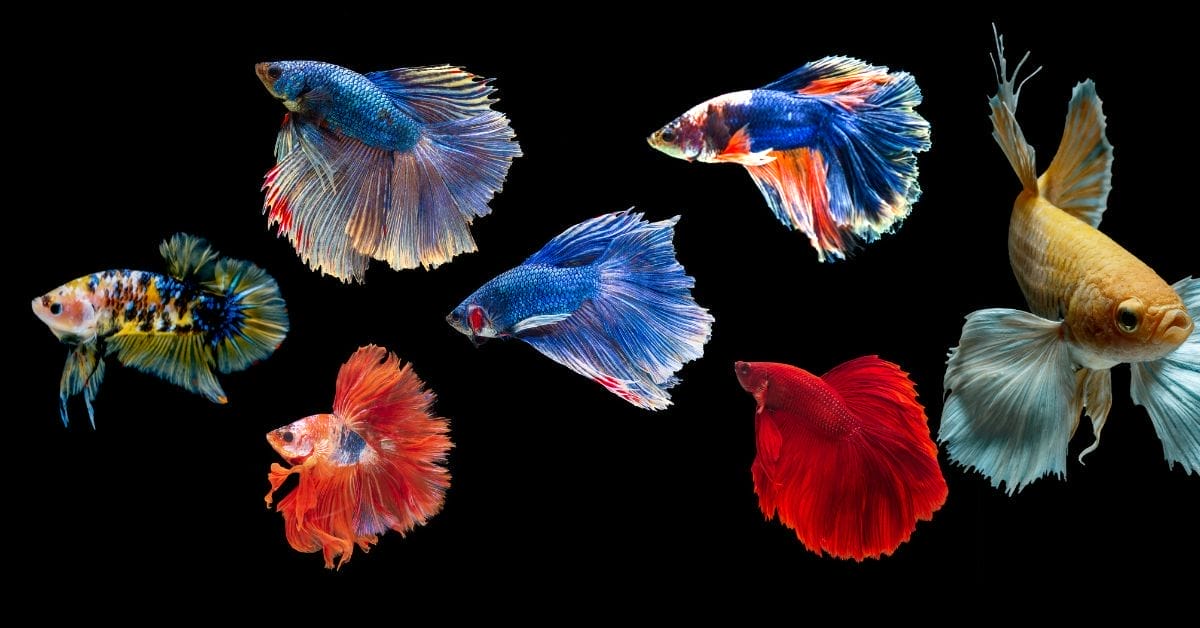
You walk into a pet store thinking you’ll just grab some fish food.
Next thing you know, you’re standing in front of the betta wall like it’s the world’s most colorful art gallery, completely mesmerized by fish that look like they’re wearing ball gowns.
The Betta Universe: Way Bigger Than You Think
Here’s something wild: when most people say “betta fish,” they’re actually talking about just ONE species out of 73 recognized species in the betta genus.
The fancy ones in pet stores? Those are all domesticated versions of Betta splendens, also known as Siamese fighting fish. But in the wild jungles of Southeast Asia, there’s a whole secret world of betta species most people never see.
Wild vs. Domestic: The Glow-Up is Real
Wild bettas are the quiet cousins at the family reunion.
They’re smaller, duller (think olive, brown, gray), and have short, practical fins. They blend into their murky rice paddies and slow-moving streams like camouflage experts. Meanwhile, their domestic relatives showed up wearing sequined tuxedos.
Over 1,000 years of selective breeding turned these humble swamp fish into living rainbows. We’re talking bright reds, electric blues, sunset oranges, and colors that don’t even have proper names yet. Some breeders have created bettas that look like they escaped from a fantasy movie.
The labyrinth organ is the secret weapon ALL bettas share. This lung-like structure lets them breathe air from the surface, which is why they can survive in those low-oxygen rice paddies. It’s basically their superpower.
Tail Types: The Main Event
The tail is where bettas really show off.

Veiltail: The Classic Starter
Long, flowing fins that cascade down like a bridal veil.
This is the betta your grandma probably had. They’re everywhere in pet stores because the veiltail gene is dominant, making them super easy to breed.
They’re generally calmer and less aggressive than other types, which makes them great for beginners. The downside? Those gorgeous long fins make them slower swimmers.
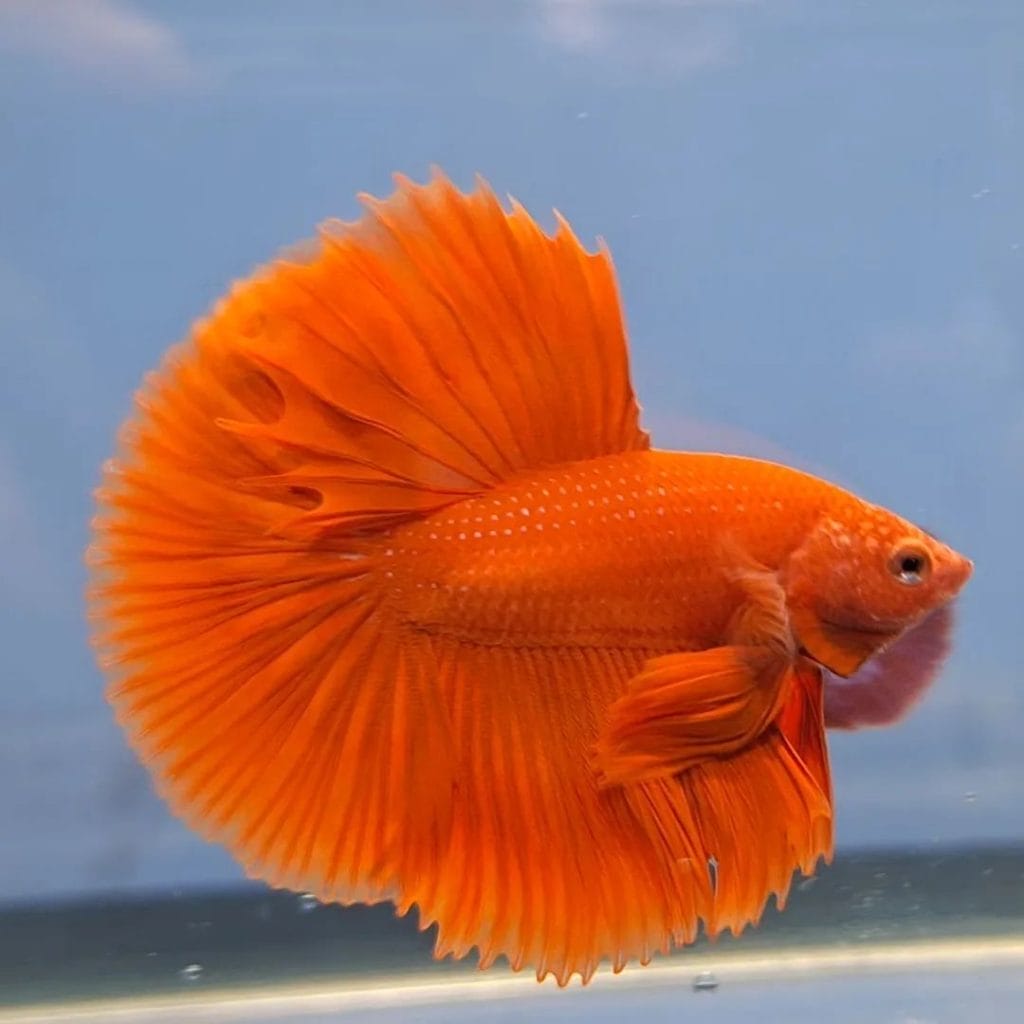
Halfmoon: The Show-Stopper
When a halfmoon betta flares, its tail spreads to a perfect 180-degree semicircle.
Like a capital D made of flowing fins. These are the supermodels of the betta world, constantly winning competitions and making other fish jealous. They come in every color combination you can imagine, from solid colors to marbled patterns that look hand-painted.
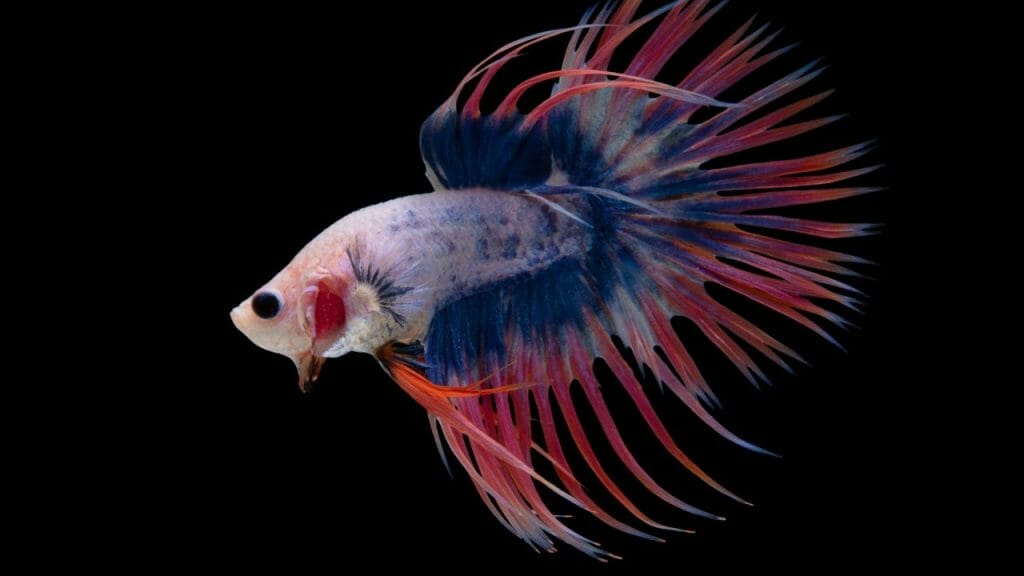
Crowntail: The Punk Rocker
The webbing between the fin rays is reduced, creating spiky extensions that look like a crown.
Created by Indonesian breeder Ahmad Yusuf only about 25 years ago, crowntails have that edgy, spiky aesthetic. The “spikes” can be single ray, double ray, or cross ray. If the webbing goes more than 2/3 up the tail, it’s actually called a combtail, which is like crowntail’s slightly less dramatic sibling.
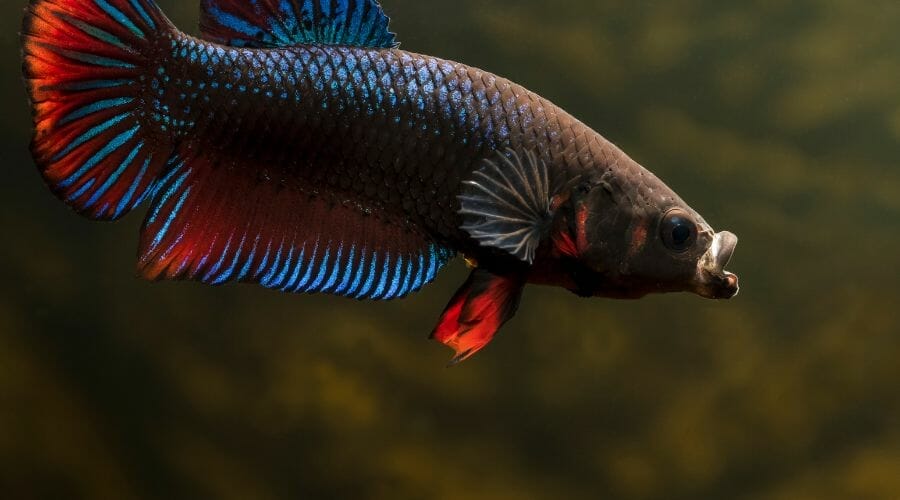
Plakat: The Fighter
Short, rounded fins and a muscular body.
These guys look closest to wild bettas and were literally bred for fighting in Thailand (hence “plakat” from the Thai “pla kat” meaning “fighting fish”). They’re faster, more aggressive, and way hardier than their long-finned cousins. Less prone to fin rot because there’s just less fin to get infected. They’re basically the athletes of the betta world.

Rosetail and Feathertail: The Drama Queens
Excessive branching in the fins creates overlapping rays that look like rose petals.
Feathertails take it even further, looking like someone glued lace doilies to a fish. They’re absolutely stunning but here’s the catch: those elaborate fins are HEAVY. These bettas struggle to swim properly and are prone to fin biting and swim bladder issues. They’re the high-maintenance fashionistas who can barely walk in their stilettos.

Double Tail: The Genetic Wild Card
Two completely separate tail lobes due to a genetic mutation.
It’s not one tail split in half—it’s literally two distinct tails. They also have wider dorsal fins. But this mutation comes with problems: interference with the swim bladder and higher susceptibility to fin rot. The offspring have low survival rates, making them relatively rare and expensive.
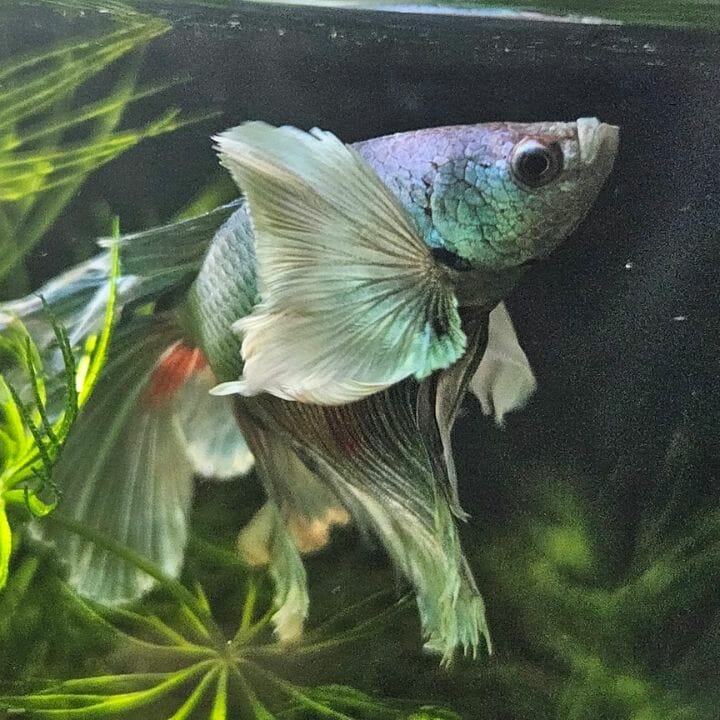
Dumbo Ear (Elephant Ear): The Wing Master
Oversized pectoral fins that look like Dumbo’s ears.
These aren’t technically a tail type, but those massive pectoral fins deserve a mention. They can appear on any tail type, which means you could have a halfmoon dumbo or a crowntail dumbo. The fins are delicate and prone to splitting, so sharp decorations are a no-go.

Delta and Super Delta: The Triangles
Delta tails spread out in a triangular shape (like the Greek letter Δ) with straight edges.
Super deltas spread between 120-160 degrees, falling just short of halfmoon’s 180. They’re sturdy, active, and don’t have the swimming problems of some fancier varieties. Think of them as the reliable middle ground.
Color Patterns: Where It Gets Crazy
Colors in bettas come from four skin layers: iridescent (top layer, usually blue/green), black, yellow, and red.
Different combinations of these layers create the mind-blowing variety you see in stores.
Solid Colors: Keep It Simple
One color across the entire fish.
Red is most common. Blue is rarer in most fish species but bettas pulled it off. Black bettas come in three types: melano (pitch black, but females are infertile making them hard to breed), black lace (not as dark), and metallic black. True albino bettas are so rare some people question if they exist—pure white with pinkish eyes, extremely sensitive to UV light.
Orange bettas are super rare in solid form. Most are bright tangerine, and you need full-spectrum lighting or they’ll look reddish. Purple bettas are practically unicorns—if you find a true purple, buy a lottery ticket that day.
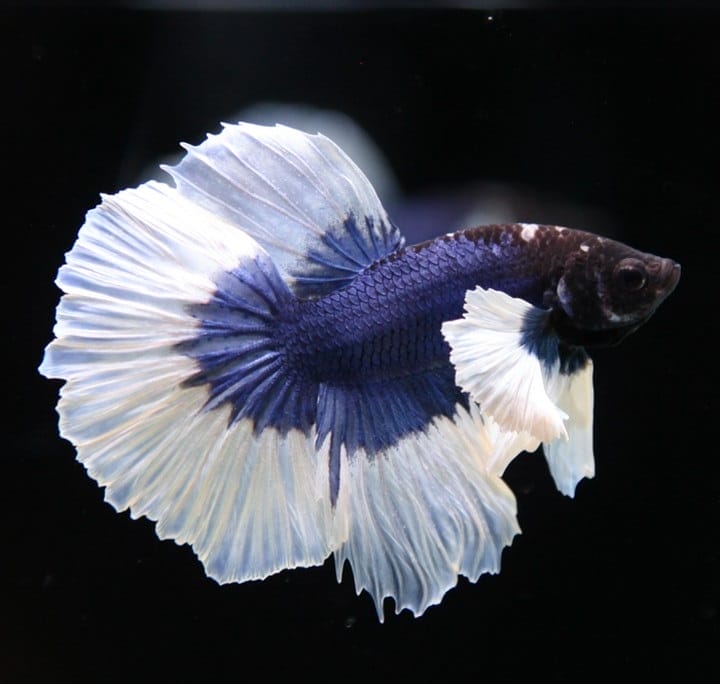
Bi-Color: Two-Tone
One color on the body, another on the fins, with no bleeding between them.
Cambodian bettas are a specific bi-color: flesh-colored bodies with deep red fins. They used to be everywhere but have been bred out over time, though some hobbyists are bringing them back.

Butterfly: The Band Pattern
Solid body color that extends to the base of the fins, then stops in a hard line, leaving the outer fins pale or translucent.
The goal is a 50/50 split, but that’s rare in breeding. For show quality, a 20% split is acceptable. With three colors, each should take up 1/3 of the fins.
Marble: The Color-Changing Magic
Splotchy color patterns across the body and fins.
Here’s the trippy part: marble bettas have a “jumping gene” that causes their colors to change over time. The fish you buy today might look completely different in six months. Originally just black and white, now marbles come in every color combo. Once the marble gene gets into a breeding line, it’s nearly impossible to remove.

Koi: The Fancy Marble
Three or more colors with marble patterning, designed to look like koi pond fish.
Usually white/cellophane bodies with red and black spots. Sub-varieties include:
- Galaxy Koi: Vibrant iridescent blue/turquoise scales creating a cosmic look
- Candy Koi: Pastel color combinations
- Samurai Koi: The rarest, with dragon scaling plus marble pattern
- Fancy Koi: High-grade with distinctive patterns
The highest grade is Koi Red Galaxy, where the scales look like tiny galaxy dots.
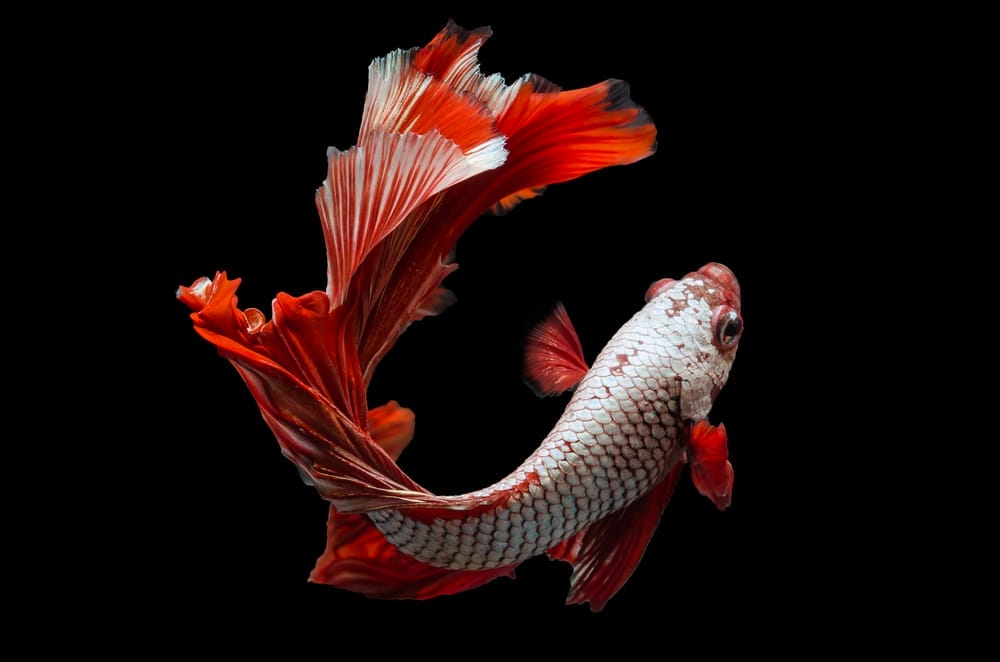
Dragon Scale: The Armored Look
Thick, metallic scales that look like dragon armor.
Usually silvery-white and opaque. They’re prone to “diamond eye,” where scales grow over the eyes causing blindness. It’s the price of looking that cool, apparently.
Grizzle: The Speckled Paint
Fine speckling that looks like someone flicked a paintbrush at the fish.
Should be a 50/50 ratio of light and dark colors. The effect resembles brushstrokes when done right.

Mustard Gas: The Toxic Combo
Blue or green body with contrasting yellow fins.
The name comes from the chemical weapon (lovely, right?), but the pattern has evolved. Now it includes fish with black bodies and blue, black, or green fin edges. Usually shown in the bi-color category.
Pineapple: The Crosshatch
Yellow body with black (or high-contrast) edging around each scale.
Creates a crisscross pattern like pineapple skin. Sometimes the fins have thin edging in the accent color too.
Multicolor: The Wild Card
Three or more colors that don’t fit any pattern category.
This is the catch-all for bettas that just do their own thing. No rules, pure chaos.
The Genetic Lottery: Why Breeding Bettas is Complicated
Bettas have 451 million base pairs in their genome.
For comparison, that’s a massive genetic code creating endless possibilities. This is why breeders can keep creating new varieties and why your marble betta keeps changing colors like it’s having an identity crisis.
Breeding for specific traits has created some issues though. Double tails have swim bladder problems. Rosetails can barely swim. Some dragon scales go blind. It’s like we bred dogs so fluffy they can’t see—beautiful, but at what cost?
Which Betta Should YOU Get?
Beginners: Veiltails or plakats are your best bet. Veiltails are chill and easy to find. Plakats are hardy and active.
Intermediate keepers: Try a halfmoon, delta, or crowntail. They’re more interesting without being high-maintenance nightmares.
Advanced aquarists: Rosetails, feathertails, or double tails if you’re up for the challenge. Or dive into the world of wild species like Betta imbellis or Betta macrostoma (a mouthbrooder that carries babies in its mouth for 18-24 days).
Color collectors: Hunt for marble bettas if you want a fish that reinvents itself. Koi bettas are trending hard right now, especially galaxy variants.
The Bottom Line
From 73 wild species living in Southeast Asian rice paddies to the hundreds of domesticated varieties strutting their stuff in pet stores, bettas are proof that selective breeding can turn a dull swamp fish into aquatic royalty.
They recognize their owners, build bubble nests, and can learn tricks. Some live up to 10 years with proper care (though 3-5 years is typical).
Just remember: that tiny cup at the pet store is NOT a proper home. Bettas need at least 5 gallons (some say 10), heated water between 76-81°F, and actual swimming space. Wild bettas have territories of about 1 square meter in nature—they’re not puddle fish despite what pet stores tell you.
Pick the variety that speaks to you, give it a proper home, and you’ll have a tiny underwater dragon that knows when you walk into the room.
Not bad for a fish that costs $5-$100 depending on how fancy you go.
About Author
Hello, I’m Muntaseer Rahman, the owner of AcuarioPets.com. I’m passionate about aquarium pets like shrimps, snails, crabs, and crayfish. I’ve created this website to share my expertise and help you provide better care for these amazing pets.
Disclaimer
This site is owned and operated by Muntaseer Rahman. AcuarioPets.com is a participant in the Amazon Services LLC Associates Program, an affiliate advertising program designed to provide a means for sites to earn advertising fees by advertising and linking to Amazon.com. This site also participates in other affiliate programs and is compensated for referring traffic and business to these companies.

